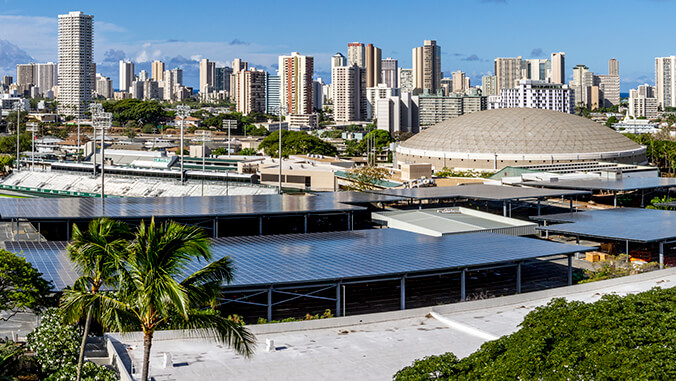
The University of Hawaiʻi at Mānoa’s Green Revolving Fund has received $50,000 through the Ulupono Fund at the Hawaiʻi Community Foundation.
UH Mānoa’s Green Revolving Fund is an internal investment fund created to reinvest cost savings and rebates from energy efficiency projects. The Green Revolving Fund is an important part of the university’s effort to move toward its “net zero” goal by 2035 to reduce greenhouse gas emissions. To date, UH has achieved just over 9% of its net zero goal and the output supported by the Green Revolving Fund will greatly contribute toward achieving this goal in less than 13 years.
Universities across the U.S. use revolving funds to provide financing upfront for energy efficiency upgrades and use the savings from the lower operating expenses, as well as rebates and other philanthropic sources, to replenish the fund.
The grant provided through the Ulupono Fund will help accelerate projects planned at the Mānoa campus, which is currently going through an exterior lighting retrofit with energy-efficient LED lighting that will use 64% less energy than the current high-intensity discharge light fixtures and have a longer lifespan and require less maintenance. UH also recently installed a solar PV shade atop the lower-campus parking structure.
Related: PV parking canopy to help UH reach net-zero goal, August 2022
“This support from the Ulupono Fund at the Hawaiʻi Community Foundation will help us complete even more efficiency projects, such as the LED light installations, while adding to the fund for future projects,” said Miles Topping, director of energy management at UH Mānoa. “We’re grateful for their support.”
“We are pleased to support UH Mānoa and its energy-efficient projects, which have the potential to save the university millions of dollars each year in energy costs by embracing energy efficiency,” said Murray Clay, Ulupono Initiative president. “This is one of many examples where we work with our partners by supporting sustainable solutions to positively help transform our community and the lives of our neighbors.”
The campus is closing a second phase of its Strategic Energy Management Master Plan, and entering a third phase, which will involve installing more solar photovoltaic panels on buildings around the campus. Other energy efficiency projects include LED lighting replacements, HVAC efficiency improvements, battery storage, water efficiency measures and waste management.

